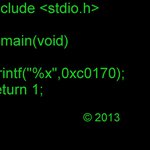This is a very simple guide, reviewing the steps required to get Blinky working on an Mbed OS platform.
Mbed OS Blinky
This example shows the use of a DigitalOut object to represent an LED and use of the nonblocking Thread::wait() call. Using nonblocking calls is good practice because Mbed OS can schedule and run other threads while the first thread is waiting.
Building this example
Building with Arm Mbed CLI
To use Mbed CLI to build this example, follow the instructions in the documentation. The instructions here relate to using the Arm Online Compiler.
To use the Online Compiler, import this code into the Online Compiler, and select your platform from the top right. Compile the code using the compile button, load it onto your board and press the reset button on the board. The code will run on the board, and you will see the LED blink.
You can find more instructions for using the Mbed Online Compiler in the documentation.
README.md
- Committer:
- mbed_official
- Date:
- 2017-02-02
- Revision:
- 24:a0164b11ed6f
- Parent:
- 14:e4cde3e77fdc
- Child:
- 27:e64a31d541da
File content as of revision 24:a0164b11ed6f:
# Getting started with Blinky on mbed OS
This is a very simple guide, reviewing the steps required to get Blinky working on an mbed OS platform.
Please install [mbed CLI](https://github.com/ARMmbed/mbed-cli#installing-mbed-cli).
## Get the example application!
From the command line, import the example:
```
mbed import mbed-os-example-blinky
cd mbed-os-example-blinky
```
### Now compile
Invoke `mbed compile` specifying the name of your platform and your favorite toolchain (`GCC_ARM`, `ARM`, `IAR`). For example, for the ARM Compiler 5:
```
mbed compile -m K64F -t ARM
```
Your PC may take a few minutes to compile your code. At the end you should get the following result:
```
[snip]
+----------------------------+-------+-------+------+
| Module | .text | .data | .bss |
+----------------------------+-------+-------+------+
| Misc | 13939 | 24 | 1372 |
| core/hal | 16993 | 96 | 296 |
| core/rtos | 7384 | 92 | 4204 |
| features/FEATURE_IPV4 | 80 | 0 | 176 |
| frameworks/greentea-client | 1830 | 60 | 44 |
| frameworks/utest | 2392 | 512 | 292 |
| Subtotals | 42618 | 784 | 6384 |
+----------------------------+-------+-------+------+
Allocated Heap: unknown
Allocated Stack: unknown
Total Static RAM memory (data + bss): 7168 bytes
Total RAM memory (data + bss + heap + stack): 7168 bytes
Total Flash memory (text + data + misc): 43402 bytes
Image: .\.build\K64F\ARM\mbed-os-example-blinky.bin
```
### Program your board
1. Connect your mbed device to the computer over USB.
1. Copy the binary file to the mbed device .
1. Press the reset button to start the program.
You should see the LED of your platform turning on and off.
Congratulations if you managed to complete this test!
## Export the project to Keil MDK and debug your application
From the command line, run the following command:
```
mbed export -m K64F -i uvision
```
To debug the application:
1. Start uVision.
1. Import the uVision project generated earlier.
1. Compile your application and generate an `.axf` file.
1. Make sure uVision is configured to debug over CMSIS-DAP (From the Project menu > Options for Target '...' > Debug tab > Use CMSIS-DAP Debugger).
1. Set breakpoints and start a debug session.

## Troubleshooting
1. Make sure `mbed-cli` is working correctly and its version is `>1.0.0`
```
mbed --version
```
If not, you can update it easily:
```
pip install mbed-cli --upgrade
```
2. If using Keil MDK, make sure you have a license installed. [MDK-Lite](http://www.keil.com/arm/mdk.asp) has a 32KB restriction on code size.
 mbed-os-examples
mbed-os-examples


 L-Tek FF1705
L-Tek FF1705